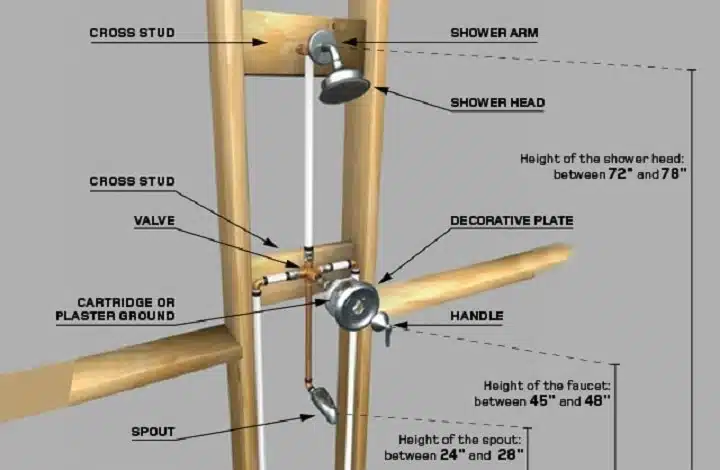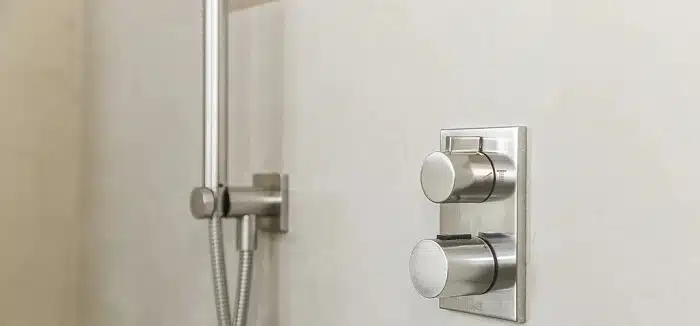
Installing a shower valve might seem straightforward, but getting the height right is crucial for both functionality and comfort. Whether you’re remodeling a bathroom or doing a new installation, knowing the standard shower valve height can help you avoid costly adjustments down the line.
This guide will walk you through the typical shower valve height, factors that may influence its placement, and tips to get it just right for your space.
What Is a Shower Valve?
A shower valve is the fixture inside your wall that controls the flow and temperature of water to your showerhead. It typically connects to your hot and cold water supply lines and is used to adjust the mix before water reaches the showerhead.
Common Shower Valve Types
| Type | Function |
| Single-handle valve | Controls temperature and flow in one motion |
| Dual-handle valve | Separate controls for hot and cold water |
| Thermostatic valve | Maintains constant water temperature |
| Pressure-balancing valve | Prevents sudden temperature changes from pressure drops |
Shower Valve Standard Shower Valve Height

The standard height for a shower valve is typically around 38 to 48 inches (96.5 cm to 122 cm) from the finished floor. However, this can vary depending on the shower style and the height of the users.
| Shower Type | Valve Height (From Finished Floor) |
| Standard Shower | 38 to 48 inches |
| Shower/Tub Combo | 28 to 36 inches (below tub spout) |
| Walk-In Shower | 42 to 48 inches |
| ADA-Compliant Shower | 38 to 48 inches (adjustable depending on user) |
These measurements can be adjusted to meet personal preferences, especially in custom-designed bathrooms.
Shower Valve Factors That Influence Valve Height
Every shower is unique. Several elements can impact the final placement of the valve.
| Factor | Impact on Valve Height |
| User height | Taller users may prefer slightly higher placement |
| Shower Head height | Valve placement typically aligns with user comfort |
| Tub installation | Tub/showers require valve placement below spout |
| Handheld shower use | Might require an additional diverter valve or lower valve |
| Code regulations | Local plumbing codes may dictate specific requirements |
Always measure from the finished floor, not the subfloor, to get an accurate placement.
Shower Valveb Shower Valve and Showerhead Alignment
For optimal performance, the valve and showerhead should be positioned with user comfort in mind.
| Component | Standard Height (From Floor) |
| Shower Valve | 38–48 inches |
| Tub Spout | 6–10 inches above tub rim |
| Showerhead | 72–80 inches |
| Handheld Mount | 48–52 inches |
The valve should be easily accessible without needing to lean, reach, or bend excessively.
Shower Valve Installation Tips
Proper installation of a shower valve ensures both long-term comfort and durability.
Pro Installation Tips
- Mark the valve center with painter’s tape during the layout phase
- Double-check stud spacing to ensure valve placement works with wall framing
- Use a level to ensure the valve is perfectly straight
- Always test water flow before closing the wall with tile or drywall
- Use escutcheons (trim plates) to cover any irregularities in the hole around the valve
If unsure, consult with a licensed plumber to verify local building code requirements.
Frequently Asked Questions (FAQ) About Shower Valve
What is the standard height for a shower valve?
Typically, it’s 38 to 48 inches from the finished floor, depending on the shower style and user preference.
Can I place a shower valve higher than the standard?
Yes, especially in walk-in showers or for taller individuals, as long as it remains easily accessible.
Where should the valve go in a tub-shower combo?
Between 28 and 36 inches from the floor, lower than a standard shower to allow easy control of both the tub spout and showerhead.
Is there a code for shower valve height?
There’s no universal code, but some local plumbing codes and ADA guidelines may specify minimum or maximum limits.
Can I install the valve myself?
If you have plumbing experience, yes — but for beginners or major remodels, hiring a professional is highly recommended.
Setting the correct shower valve height is key to a well-designed bathroom that blends comfort, code compliance, and long-term durability. Whether you’re doing a custom walk-in, a modern rain shower, or a traditional tub-shower combo, always take the time to measure properly and plan ahead.




